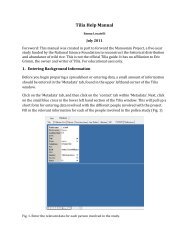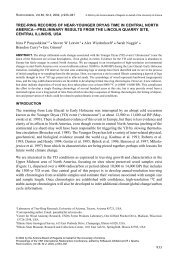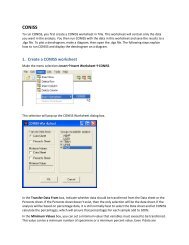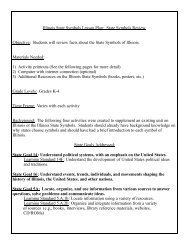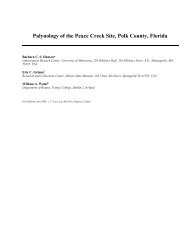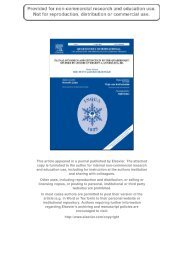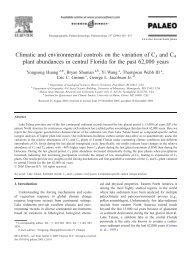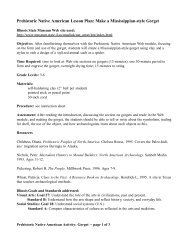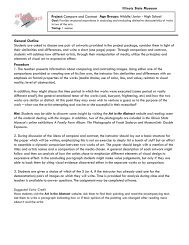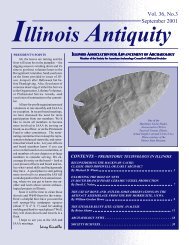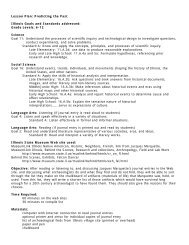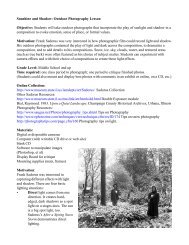MuseumLink Native American Native American Lesson Plan
MuseumLink Native American Native American Lesson Plan
MuseumLink Native American Native American Lesson Plan
- No tags were found...
You also want an ePaper? Increase the reach of your titles
YUMPU automatically turns print PDFs into web optimized ePapers that Google loves.
Illinois State Museum – <strong>MuseumLink</strong> <strong>Native</strong> <strong>American</strong><strong>Native</strong> <strong>American</strong> <strong>Lesson</strong> <strong>Plan</strong>: Someone's in the KitchenObjectives:After reading the materials in the <strong>Native</strong> <strong>American</strong> historical web site and the recipe directions, studentswill be able to use the vocabulary necessary to complete the cooking activities and tell others about thefood. After practicing using the measuring instruments and utensils in the recipes, students will be able todifferentiate among various cooking measurements with an 80% accuracy or above. After reading the Webmaterials and completing the activity, students will be able to discuss the similarities and differencesbetween <strong>Native</strong> <strong>American</strong> and other nationalities' foods made in their families. After listening to thecontent of the materials, and doing the cooking activity, ESL students will be able to understand and usethe vocabulary of the lesson, make measurements, and make simple oral comparisons between the foods inthe activity and their family's foods.Motivation:Have students view the online recipes and choose some that look good to them. Discuss the recipes withthe students in a pre-cooking lesson, looking at ingredients and methods of cooking. The class may decidewhich recipes it would like to prepare. Also discuss how these ingredients were procured and how weprocure our foods. Note that these recipes are contemporary, but based on very old traditional ones. Arethere traditional recipes still prepared in the students' families? Are any of the dishes seasonal? How do youknow?Materials:See the following online recipes for equipment and ingredients:<strong>Native</strong> <strong>American</strong> Indian Resources section on recipes.http://indy4.fdl.cc.mn.us/~isk/food/recipes.html#menuSearchable Online Archive of Recipes, <strong>Native</strong> <strong>American</strong> sectionhttp://godzilla.eecs.berkeley.edu/recipes/ethnic/native/Optional cooking situations could be: the school kitchen in off-lunch hours, a hotplate for boiling or frying;or microwave oven in the classroom, or a toaster oven for baking, depending on the recipe and age of thestudents.Procedure:See recipes for preparation procedures. Be sure to have the students answer questions and talk theirway through the cooking to use the new vocabulary. Each group could present their dish to the classwith a summary of their ingredients, method of preparation.Assessment:Students fill out a form that assesses how they think they did on working as a team member, followedinstructions, used new vocabulary, and summarized what they learned about another culture. The teacherwill give the vocabulary and spelling test mentioned, with words chosen according to the words the classused in their activity. (See word list)
Self-Assessment Form for Someone's in the Kitchen <strong>Lesson</strong>Please rate yourself and your team on the following parts of the lesson by circling the letter you thinkmatches your performance.Teamwork:I fulfilled my assignments on my team.very well okay not very well not at allThe best thing I did on this project as part of a team was__________________________________________________________________________________ ___Something I could have done better for my team was __________________________________________________________________________________________________________________My team members did this really well: ______________________________________________________Something my team members could have improved is __________________________________________Vocabulary Learning:I scored ________ on my vocabulary test becauseAs a result of this activity, I will be able to talk about cooking and <strong>Native</strong> <strong>American</strong> foodsvery well okay a little bit not at allMeasurements:As a result of this activity, I feel able to measure recipe ingredientsvery accurately usually accurately sometimes accurately not at allThe most difficult part of following a recipe is _______________________________________________I will probably try cooking again.definitely probably probably not neverUnderstanding and appreciating other cultures:As a result of this activity, I know more about <strong>Native</strong> <strong>American</strong> culture in Illinois and can compare it tomy cultural traditions.For example I learned: _______________________________________________________________________________________________________________________________________________________Among the foods we cooked, the food I liked the best is the _____________________________________
Vocabulary List for Someone's in the Kitchen(List may vary from vocabulary used on other Web sites)agriculturecultivatestaple (food)to beatto blendto chopto diceto draindrippingsto garnishhominyto hullto peelponeto preheatto pureeto sauteto seedtepid
Illinois Goals and Standards addressed:Application of Learning: Working on TeamsLanguage ArtsAll Levels: Goal 1: Comprehend a broad range of reading materials.Standard A: Apply word analysis and vocabulary skills to comprehend selections.Standard B: Apply reading strategies to improve understanding and literacy.MathematicsAll Levels: Goal 7: Estimate, make and use measurements of objects, quantities, and relationships, anddetermine levels of accuracy.Standard A: Measure and compare quantities using appropriate units, instruments, and methods.Social Science:All Levels: Goal 18: Understand social systems, with an emphasis on the United States.Standard A: Compare Characteristics of culture as reflected in language, literature, the arts, traditions, andinstitutions.For ESL students:Goal 28: Use the target language to communicate within and beyond the classroom setting.Standard A: Understand oral communication in the target language.Stage 2: 28.A.2b: Follow instructions in the target language, given one step at a time.Stage 3: 28.A.3b: Follow instructions in the target language as given in multi-step segments.Standard B: Interact in the target language in various settings.Stage 1: 28.B.1b: Imitate pronunciation, intonation, and inflection including sounds unique to the targetlanguage.Stage 2: 28.B.2a: Pose questions spontaneously in structured situations.28:B.2c: Produce language using proper pronunciation, intonation, and inflection.Stage 3: 28.B.3a: Respond to open-ended questions and initiate communication in various situations.28.B.3b: Produce language with improved pronunciation, intonation, and inflection.Goal 30A: Use the target language to make connections and reinforce knowledge and skills acrossacademic disciplines.Stage 2: 30.A.2b: Use the target language to make, use, and estimate measurements.Stage 4: 30.A.4d: Use the target language to describe and compare daily diet, nutrition in areas where thetarget language is spoken.



